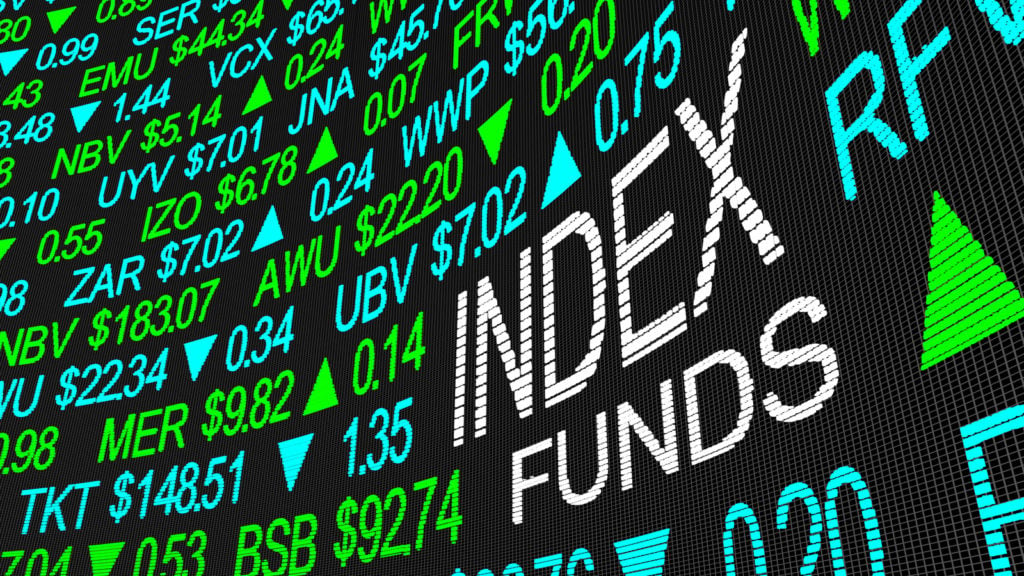Fidelity Investments’ history goes back to the early 1940s. Many investors associate mutual funds with Fidelity. However, in recent years, the company has increased its exchange-traded funds. Therefore today, we’ll introduce seven Fidelity index funds that can help diversify your long-term portfolio.
Lucian Bebchuk and Scott Hirst of the National Bureau of Economic Research in Cambridge, Massachusetts, highlight, “Index funds – investment funds that mechanically track the performance of an index – hold an increasingly large proportion of the equity of U.S. public companies.”
An ETF is a security listed on a stock exchange. It tracks a stock index, a commodity, bonds, or a basket of assets. Therefore, returns of an ETF that track a benchmark index portfolio typically mimic the returns of that index, such as the S&P 500.
Recent research suggests, “Exchange-traded funds, whose securities are traded at the secondary market, pose as one type of index funds.”
Although there are differences between index funds and ETFs, many investors use them interchangeably. For instance, ETFs trade on exchanges just like shares. But index funds are typically bought directly with the fund manager.
As a result, there are some differences in expenses and year-end tax consequences. A financial planner would be able point most retail investors in the right direction appropriate for their risk/return profiles.
With that information, here are seven seven fidelity index funds and ETFs that deserve your attention in February:
- Fidelity 500 Index Fund (MUTF:FXAIX)
- Fidelity Large Cap Growth Index Fund (MUTF:FSPGX)
- Fidelity MSCI Consumer Discretionary Index ETF (NYSEARCA:FDIS)
- Fidelity MSCI Consumer Staples Index ETF (NYSEARCA:FSTA)
- Fidelity MSCI Financials Index ETF (NYSEARCA:FNCL)
- Fidelity Total Bond ETF (NYSEARCA:FBND)
- Fidelity US Sustainability Index Fund (MUTF:FITLX)
Index Funds: Fidelity 500 Index Fund (FXAIX)

If you are looking for a cheap tool for diversification, then look no further than the Fidelity 500 Index Fund. The fund seeks to provide investment results that closely replicates the S&P 500 index, holding each security at approximately the same weight as the index. The fund started trading in May 2011 and has around $285 billion net assets. It has an expense ratio of 0.015% and a dividend yield of 1.62%.
FXAIX is invested in 508 different stocks. Portfolio weight of major sectors include information technology with 27.55%. Then come healthcare (13.44%) and consumer discretionary (12.70%).
About 28% of the assets are in the top 10 names. Consumer electronics giant Apple (NASDAQ:AAPL), software developer and tech darling Microsoft (NASDAQ:MSFT) and online retail leaders Amazon (NASDAQ:AMZN) lead the names in the roster. Over the past year, FXAIX is up about 17%. I believe this could be a cornerstone fund for many retail portfolios.
Fidelity Large Cap Growth Index Fund (FSPGX)

The Fidelity Large Cap Growth Index Fund tracks the returns of the Russell 1000 Growth index, a market capitalization weighted index focusing on the large-cap growth segment of the U.S. equity market. The fund currently holds 456 stocks. Since its inception in June 2016, net assets reached $6.4 billion.
IT (44.48%), consumer discretionary (16.67) and healthcare (13.49%) are the top three sectors. The leading 10 holdings constitute more than 44% of the fund. Apple, Microsoft, and Amazon head the list in FSGPX as well.
This fund returned 34% in the past year, thanks to its significant exposure to the leading tech shares. In 2020, many of these businesses had robust sales growth, profitability, as well as price momentum. The fund’s dividend yield 0.73% and has an expense ratio of 0.035%.
I believe FSGPX’s low expense ratio makes it an attractive holding for investors with long-term investment horizons.
Fidelity MSCI Consumer Discretionary Index ETF (FDIS)

From large caps, we move to the consumer. The Fidelity MSCI Consumer Discretionary Index ETF gives access to consumer discretionary businesses that offer non-essential products and services. When the economy contracts, many consumers decrease their spending on such discretionary purchases.
InvestorPlace.com readers should distinguish the consumer discretionary sector from the consumer staples sector. The staples sector includes essential items that people could not give up easily, such as food or drugs, even in economically difficult times.
FDIS, which tracks the MSCI USA IMI Consumer Discretionary Index, has 277 holdings. Since its inception in October 2013, net assets have grown to $1.3 billion. Sector breakdown includes: internet and direct marketing retail (29.23%), specialty retail (18.62%), hotels, restaurants and leisure (15.24%), automobiles (13.08%), textiles, apparel and luxury goods (7.24%), household durables (4.56%), and others. The top 10 stocks comprise more than half of the fund.
Amazon, Tesla (NASDAQ:TSLA), Home Depot (NYSE:HD), and Nike (NYSE:NKE) top the names in the ETF. Readers should note that the weighting of AMZN and TSLA stocks is 22.81% and 10.81%, respectively. Thus a large move either stock’s share price is likely to have a big effect on this top-heavy fund.
Over the past 12 months, the fund has returned about 53%. Trailing P/E and P/B ratios are 33.64 and 6.98, respectively. There could be some short-term profit-taking in many of the stocks in the fund. A decline toward $72.50 or below would improve the margin of safety.
The fund’s expense ratio is 0.08% and it pays a dividend yield of 0.57%.
Economists still debate the shape of the economic recovery after the novel coronavirus pandemic. But consumer discretionary spending is likely to increase over time. Therefore, an ETF like FDIS deserves your attention.
Index Funds: Fidelity MSCI Consumer Staples Index ETF (FSTA)

Unlike FDIS, the Fidelity MSCI Consumer Staples Index ETF invests in the consumer staples sector. FSTA, which has 99 holdings, tracks the returns of the MSCI USA IMI Consumer Staples Index. The fund started trading in October 2013 and has around $851 million in net assets.
According to the sub-sectoral breakdown of the ETF, beverages and household products have highest portions in the ETF with 23.59% and 23.09%, followed by food and staples retailing sector with a 20.91% slice.
FSTA’s top 10 holding accounted for 62.4% of all holdings in the fund. The leading consumer product manufacturer Procter & Gamble (NYSE:PG) is the most-held stock in the ETF. Retail giant Walmart (NYSE:WMT) and the world’s largest nonalcoholic beverage company Coca-Cola (NYSE:KO) are the two other leading names in the fund.
The fund’s dividend yield is 2.5% and it charges an expense ratio of 0.08%.
Over the past year, FSTA has returned about 5%. Valuation levels in many sectors of the S&P 500 are at record highs. However, consumer staples is not one of those segments. Potential investors could regard dips in price as an opportunity to buy the shares.
Fidelity MSCI Financials Index ETF (FNCL)

The Fidelity MSCI Financials Index ETF provides exposure to financial firms. Banks have the highest allocation with a 37.58% share, followed by the capital markets (26.12%) and insurance sub-sectors (18.85%).
FNCL, which has 393 stocks, tracks the MSCI USA IMI Financials 25/50 Index. The fund started trading in October 2013 and has about $908 million in net assets.
The top ten holdings constitute over 40% of the ETF. JP Morgan (NYSE: JPM), Berkshire Hathaway (NYSE:BRK.A) (NYSE:BRK.B), and Bank of America (NYSE:BAC) are the leading shares in the fund.
The fund pays a dividend yield of 2.14% and its expense ratio is 0.08%.
FNCL is up less than 1% in the past year. However, year-to-date, it has returned about 6%. As the third round of fiscal stimulus becomes more likely, market participants concur that bank stocks may fare better in 2021. A significant number of consumers are likely to pay off debts that they may have, which would reduce the credit risk for the nation’s banks.
Furthermore, seasoned investors like bank shares mostly for stable dividends and share repurchases. In December 2020, following a series of stress tests, the Federal Reserve allowed banks to resume stock buybacks, giving a big support to financial stocks. I believe long-term investors would find value in a fund like FNCL.
Fidelity Total Bond ETF (FBND)

The Fidelity Total Bond ETF provides diversification in the fixed income space. It also offers current income. The fund invests in government, mortgage, investment-grade corporate and junk bonds. About 85% of the holdings are U.S.-based. I like the large U.S. allocation of the fund as a positive as international bonds tend to have lower yields and inconsistent dividends.
FBND, which has 1450 holdings, tracks the Bloomberg Barclays Aggregate Bond Index, and has 1451 holdings. Since its inception in October 2014, assets under management have reached $1.8 billion.
The fund’s expense ratio is 0.36%. Dividend yield is 4.42%.
Over the past 52 weeks, this ETF has returned about 3%. Bond ETFs, like FBND, are baskets of bonds that trade on a stock. exchange. Thus the fund is liquid and easy to trade. Many investors are likely to consider allocating some of their capital in a bond fund and collect regular income. I find FBND to be a well-managed and diversified fund.
Index Funds: Fidelity US Sustainability Index Fund (FITLX)

Our final fund is the Fidelity US Sustainability Index Fund, which tracks the returns of the MSCI USA ESG Leaders Index. The fund’s focus is on large to mid-caps with high environmental, social, and governance (ESG) performance relative to their sector peers, as rated by MSCI ESG Research.
FITLX currently holds 268 stocks. It started trading in May 2017 and has around $690 million in net assets. The information technology sector has highest portion with 27.12%, followed by consumer discretionary and healthcare sectors with 13.94% and 13.43%, respectively.
The fund’s dividend yield is 1.02% and its expense ratio is 0.11%.
Its top 10 holdings account for 32.72% of the funds. Microsoft, Alphabet (NASDAQ:GOOG) (NASDAQ:GOOGL), and Tesla are among the leading names in the roster.
The fund is up close to 18% in the past 12 months. 2020 saw ESG investing gain more traction, a trend I believe is likely to continue well into the new decade. A whole new generation of investors who focus on ESG factors might be entering the markets.
On the date of publication, Tezcan Gecgil did not have (either directly or indirectly) any positions in the securities mentioned in this article.
Tezcan Gecgil has worked in investment management for over two decades in the U.S. and U.K. In addition to formal higher education in the field, she has also completed all 3 levels of the Chartered Market Technician (CMT) examination. Her passion is for options trading based on technical analysis of fundamentally strong companies. She especially enjoys setting up weekly covered calls for income generation.
